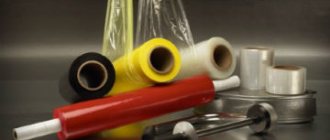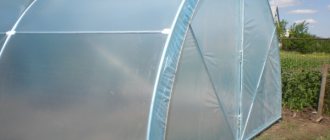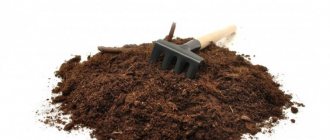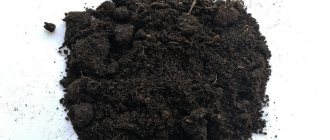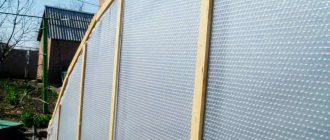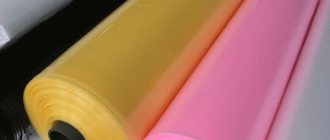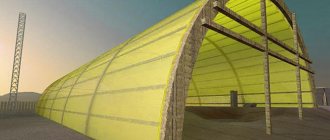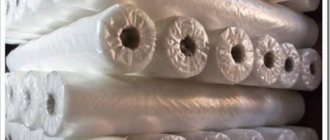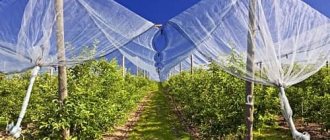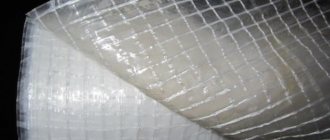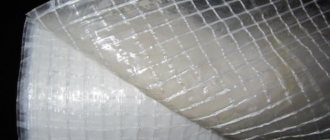Polyethylene film is the cheapest type of covering for greenhouses. It is attractive due to its high transparency, permeability to sunlight, and ability to accumulate heat. The disadvantage of conventional polyethylene is its lack of UV resistance. Unstabilized film degrades in the sun within two to three months.
To increase the service life of the material, manufacturers add light stabilizers for polyethylene to the polymer mass. These substances protect the canvas from rapid destruction. Depending on the volume and quality of stabilizers, the film can last from one year to 10 years. This material is called perennial; it is suitable for private greenhouses and commercial greenhouse complexes.
↑ Stabilized hydrophilic polyethylene film
Stabilized hydrophilic polyethylene film is characterized by the formation of condensation on its surface. However, unlike a simple film, water droplets roll down without forming a drop. And thanks to antistatic additives, this type of film does not become covered with dust so quickly and remains transparent.
At night, due to the formation of water on the inner layer, less heat is lost, and infrared rays practically do not penetrate.
Since this type of film promotes the formation of a constant temperature, the greenhouse will have a bountiful harvest! The main thing is to properly wrap the reinforced base and secure the film.
Light stabilized black and white film - where to get it and what is the difference from black film?
Light-stabilized black and white film is intended exclusively for summer cottages. An example of the use of such material would be sealing temporary windows, as well as flower beds and greenhouse complexes. For small courtyard greenhouses, clear plastic sheeting is best.
It's no secret that polyethylene film can maintain temperature, protecting the inner surface in which plants are hidden from overheating. This fact allows you to create small flower beds over the entire surface of the summer cottage.
The atmosphere will not always be favorable for the growth of cultivated plants in a greenhouse. It is to create a favorable internal climate that this film must be used. If you need to protect plants from ultraviolet radiation, you can use a dark polyethylene film. If this is not necessary, then you can get by with a simple option with a transparent composition.
Atmospheric phenomena will no longer be an obstacle to a good harvest, because the film will reliably protect it from everything that can happen around (within reasonable limits, of course).
This film is best suited as greenhouses, although some of its varieties, for example, black, are very suitable for bags and other consumables for recycling and transporting waste. Agricultural enterprises and dacha partnerships increasingly began to use polyethylene film for their personal needs.
Classic transparent polyethylene film has been used in agriculture and summer cottages for quite a long time. As time passed, many scientists began to seriously think about improving the traditional polyethylene composition in order to ultimately obtain a material even stronger and more practical than it was before. They decided to add a special composition of dye, soot and adhesive to the film. This is how, in the end, a high-class film was created, which almost completely replaced the traditional one.
As for light-stabilized film in black and white, it is not necessary for all gardeners, but only for those who want to protect their plants from sunlight and protect seedlings from damage in the future.
The scorching sun in some southern regions of Russia can simply destroy some of the green plants planted in the wrong place.
Classic polyethylene film was created a long time ago and, by the standards of innovation, began to become obsolete. In order to squeeze as much as possible out of the material, the film began to be improved in every possible way, making more and more modifications aimed at a narrow user. That same light-stabilizing film is precisely such a modification.
It is divided into two types, namely:
- Black.
- Light.
Each of them is needed by its consumer and adds certain properties to a particular structure. These varieties and the subtype of films that stabilize light rays should be discussed in this article. Each type differs from each other not only in its qualities, but also in the degree of thickness, as well as the size of the final product delivered to the construction site.
There are several types of polyethylene film:
- Classic.
- Reinforced.
- Colored.
- Solid.
- Film type, which is an ordinary thin smooth film of polyethylene. As a rule, it is of low density and is used in highly specialized industries.
The structure and purpose of each of the above types is its own and differs almost one hundred percent.
During the development of films with light stabilizers, the vast majority of the shortcomings that were made in other versions of this material were corrected. This type of polyethylene does not allow moisture to pass through, and also tends to retain warm air from the inside, making the microclimate in the created room softer than in the case of glass or plastic tiles placed on top.
If you compare the film with the materials mentioned above, then, definitely, the film will look much better and also be used. When comparing traditional types of films, the ability of each to retain heat and stop cold is taken into account. Here this ability is present and has an additional reserve of five degrees Celsius.
Stabilizing light film has many differences from the classic one, such as improved mechanical and physical properties. Now the film has been improved so much that it can not only protect the surface underneath, but also create all the necessary conditions for the development of a particular climate inside a greenhouse or greenhouse in a garden on a summer cottage outside the city.
The elasticity of the stabilization film can only be envied by its brothers and competitors. It all lies in the formula used by film manufacturers.
↑ Polyethylene film heat-retaining
This type of film is characterized by high absorption of thermal radiation. If you are looking for ways to save on heating a greenhouse, then this type of film is the best solution. According to studies, the temperature in a greenhouse with such a film is 1-3 degrees Celsius higher than in an unstabilized or stabilized one. Polyethylene heat-retaining film also has a hydrophilic surface and antistatic properties.
As practice shows, the vegetable yield in such a greenhouse is 10-30 percent higher than in others!
Among the disadvantages, it is worth noting low strength. The film can last no more than 9 months.
Read more about how to choose the right light-stabilized black film
Plants protected with this material will grow better than their unprotected counterparts. That is why you should purchase a fabric such as black light-stabilized film for your summer cottage or suburban area.
In gardening and agriculture, black and white light-stabilized polyethylene film is used in the following structures:
- Greenhouses.
- Flowerbeds.
- Temporary agricultural structures for storing seeds and other consumables for the garden.
- Greenhouses for growing vegetables in special conditions.
↑ Ethylene vinyl acetate copolymer film
Perhaps this is the most durable type of film for greenhouses and greenhouses. At the same time, unlike other types of films, it is light-resistant, elastic and retains heat well. The copolymer film is also resistant to strong winds, punctures and frost.
The only drawback of this film is that on hot days too much heat can enter the greenhouse.
The service life of copolymer ethylene vinyl acetate film is 3 years.
Light-stabilized polyethylene properties
Among the technical properties of perennial films, the following should be noted.
- Thermal resistance. The canvases demonstrate resistance to negative and high temperatures, so there is no need to remove them for the winter.
- Strength. Manufacturers provide that in winter the canvas may be subject to pressure from snow cover, so they take care of sufficient elasticity of polyethylene.
- Light transmission. PE is required to maintain transparency at the original level throughout its service life.
To realize these characteristics, the introduction of new technologies, the use of raw materials with established properties, and reliable light stabilizers are required. This is reflected in the cost of production, which is higher than typical film. But if we consider the service life of long-term PE, it is wrong to call it expensive. It is more convenient and profitable to use the canvas in a greenhouse for seven to ten years than to update the shelter annually.
There are no analogues to perennial polyethylene in terms of convenience and availability. But they do not have specific requirements for use. The canvases are installed on the frame of a greenhouse or greenhouse, secured with wooden slats, with low tension. In case of local damage, tape can be used for repair.
↑ Polyvinyl chloride film
Today, PVC film has become much more durable and elastic. The service life of the film is as much as 8 years!
PVC film has low infrared permeability, and thanks to this it retains high temperatures at night. However, due to the low transmittance of infrared rays - only 20 percent, it cannot be used everywhere.
Although PVC film gets dirty very quickly, it can be quickly washed with water.
In addition to all known polyethylene films, new coatings are also undergoing an experimental stage today. Recently, a film was created that can convert short-wave ultraviolet radiation into long-range red radiation. Under such a film, tomatoes are able to grow 2 times faster due to high photosynthesis!
What is the temperature regime for this type of film?
The black and light versions of the film have relatively identical temperature limits, below which you should not fall, as there is a risk of damaging not only the finished structure, but also the plants inside it. According to data taken from hardware stores, the minimum frost threshold for plants under the film is eight degrees. This is a very good indicator, since it is better to only transfer plants from the greenhouse to a heated room.
Elasticity increases the time during which this material can be used for its intended purpose. We will not talk about recycling here, since it is this material that is most difficult to process into another, lower-quality option.
As for strength, it is the golden mean. In general, this indicator will vary depending on the thickness of the film itself. The service life also depends on the thickness, because a material with a high density will look better after a year, and a thin film will exhaust its strength resource after a few months. There is also such film that is enough for only one season. As a rule, it is not too expensive and is sold in almost all hardware stores. It is not uncommon for them to be sold at markets in rural areas, and people willingly take them, using them not just once, but stretching them out over several seasons.
Negative factors that waste the film's life can be either ultraviolet rays or temperature changes. Dark polyethylene film is not afraid of the sun's rays. It is precisely this that must be purchased in the hot southern areas of the Krasnodar Territory, Rostov Region and other places where at peak times the thermometer rises to thirty degrees or more.
The color range of the stabilizing film varies depending on the degree of use.
Now it’s worth talking about colors:
- Light is the initial level from which a gardener or summer resident begins to become acquainted with the world of plastic films with a stabilizing effect. Suitable for small flower beds, greenhouses and hotbeds that are not exposed to the scorching sun.
- Light green is the golden mean between the first and next options. If the first type is more suitable for a temperate climate and not too specialized use, then this type is suitable for everything at once. By choosing it, the user will not bother with the selection of material.
- The black stabilizing film is the maximum level of protection against harmful sunlight during the daytime. Since black color tends to retain more heat, a greenhouse made of dark polyethylene materials is suitable for creating a warm microclimate inside at night.
The above types of stabilizing polyethylene film make it possible to make it clear to the consumer that manufacturers care about him. Now a visitor to a construction market or hardware store can choose between three films or try them all, depending on their needs on the site or construction site.
